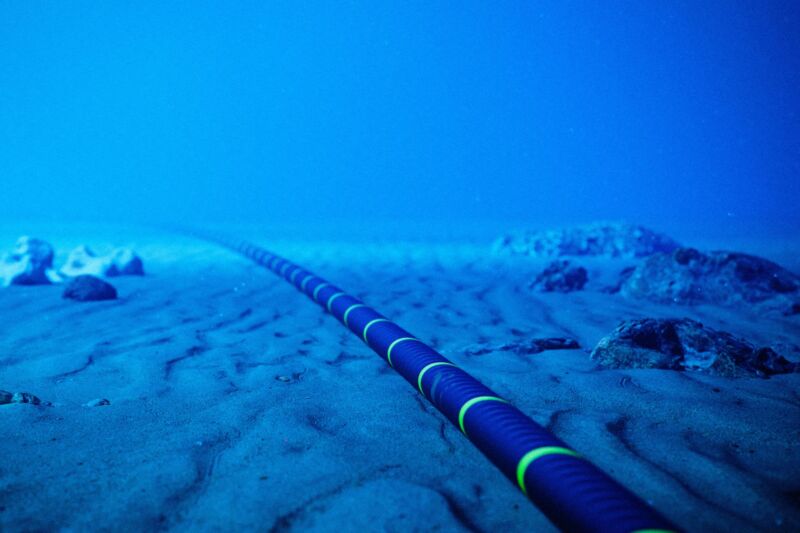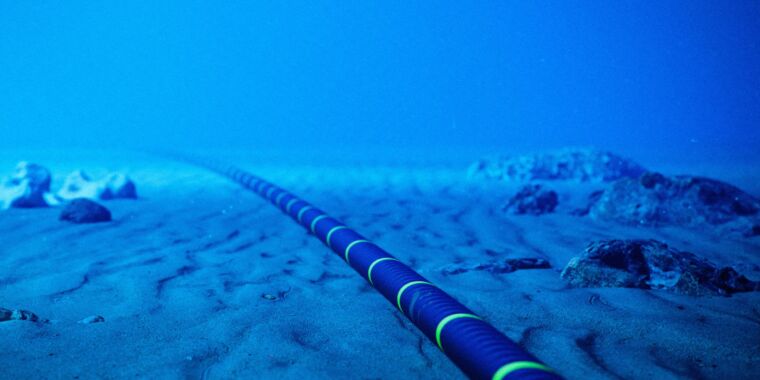
imaginima/Getty Images
The Asia-Africa-Europe-1 internet cable travels 15,500 miles over the seabed, connecting Hong Kong to Marseille, France. As it winds through the South China Sea to Europe, the cable helps provide internet connections to more than a dozen countries, from India to Greece. When the cable was cut on June 7, millions of people were offline and experiencing temporary internet outages.
The cable, also known as AAE-1, was cut where it runs briefly overland through Egypt. Another cable was also damaged in the incident, the cause of the damage is unknown. However, the impact was immediate. “It involved about seven countries and some over-the-top services,” said Rosalind Thomas, the director of SAEx International Management, which plans to create a new submarine cable connecting Africa, Asia and the US. “The worst was Ethiopia, which lost 90 percent of its connectivity, and then Somalia also lost 85 percent.” Cloud services from Google, Amazon and Microsoft were also all disrupted, a later analysis found.



Though connectivity was restored within hours, the outage highlights the vulnerability of the world’s more than 550 undersea Internet cables, plus the excessive role Egypt and the nearby Red Sea play in Internet infrastructure. The global network of underwater cables is much of the backbone of the Internet, carrying most of the data around the world and eventually connecting to the networks that power cell towers and Wi-Fi connections. Submarine cables connect New York to London and Australia to Los Angeles.
Sixteen of these submarine cables — often no thicker than a garden hose and vulnerable to damage from ship anchors and earthquakes — travel 1,200 miles through the Red Sea before jumping overland into Egypt and heading to the Mediterranean, connecting Europe to Asia. . Over the past two decades, the route has emerged as one of the world’s biggest internet bottlenecks and arguably the most vulnerable place on Earth to the internet. (The region, which includes the Suez Canal, is also a global bottleneck for shipping and freight traffic. Chaos ensued when the container ship ever given got stuck in the canal in 2021.)
“Where there are bottlenecks, there are some points of failure,” said Nicole Starosielski, an associate professor of media, culture and communications at New York University and author of submarine cables. “Being a place with an intense concentration of global movement makes it more vulnerable than many other places in the world.”
The area has also recently attracted the attention of the European Parliament, which identified it as a risk for widespread internet disruption in a June report. “The main bottleneck for the EU concerns the passage between the Indian Ocean and the Mediterranean Sea via the Red Sea, as the main connections to Asia are via this route,” says the report, identifying extremism and maritime terrorism as risks in the EU. area.
pyramid scheme
Look at Egypt on a map of the world’s undersea internet cables and it becomes immediately apparent why internet experts have been concerned about the area for years. The 16 cables in the area are concentrated by the Red Sea and touch down in Egypt where they travel 100 miles across the country to reach the Mediterranean Sea. (Cable maps do not show the exact locations of cables.)
It is estimated that about 17 percent of the world’s Internet traffic goes through these cables and through Egypt. Alan Mauldin, the research director for telecom market research firm TeleGeography, says the region had 178 terabits of capacity last year, or 178,000,000 Mbps. The US has median home internet speeds of 167 Mbps.
Egypt has become one of the most prominent hot spots on the internet for a number of reasons, said Doug Madory, director of internet analytics at surveillance firm Kentik. Primarily, the geography contributes to the concentration of cables in the area. Through the Red Sea and through Egypt is the shortest (mostly) underwater route between Asia and Europe. While some intercontinental internet cables run overland, it is generally safer to lay them at the bottom of the sea, where they are more difficult to disrupt or snoop on.
Passing through Egypt is one of the few practical routes available. In the south, the cables that run around Africa are longer; while in the north only one cable (the Polar Express) runs over Russia. “Every time someone tries to map out an alternate route, you end up going through Syria or Iraq or Iran or Afghanistan — all these places have a lot of problems,” Madory says. The JADI cable system that bypassed Egypt was shut down due to the Syrian civil war, Madory says, and it has not been reactivated. In March this year, another cable evading Egypt was cut as a result of Russia’s large-scale invasion of Ukraine.

